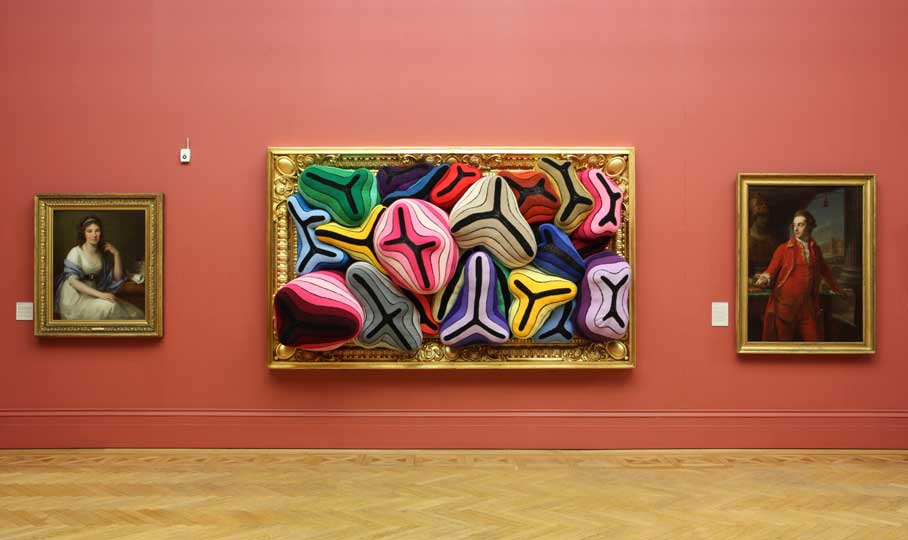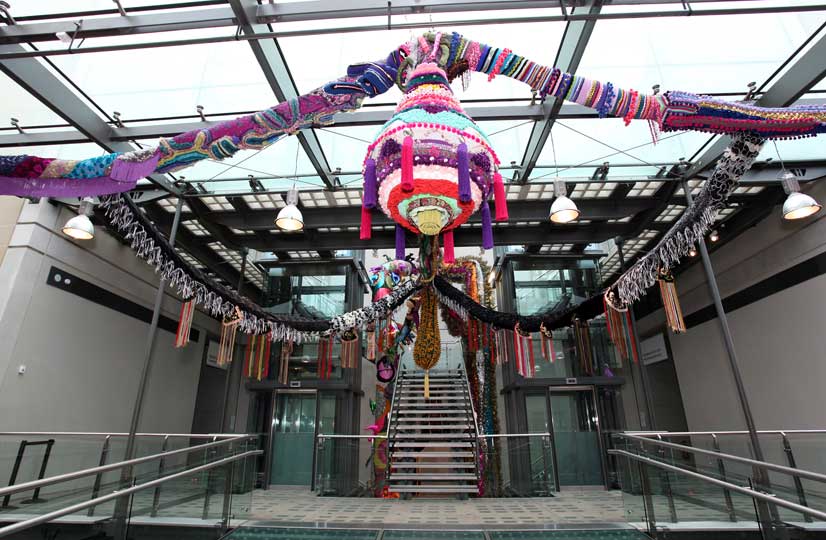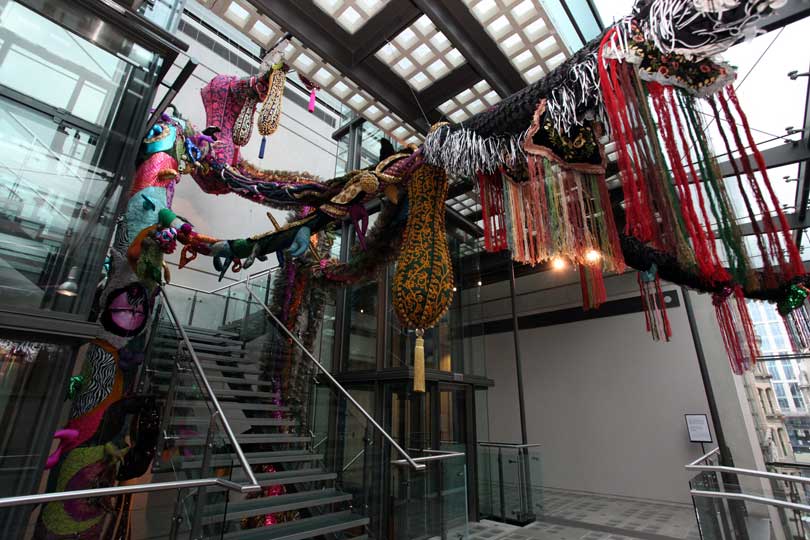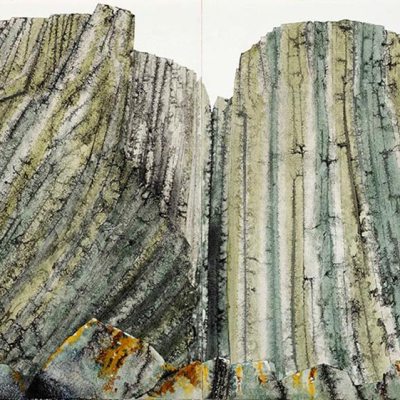Seven years ago I went to The New Art Gallery Walsall to see a show of work by Joana Vasconcelos. Hanging in the vast atrium was the magnificent five metre high tampon chandelier, The Bride, which had shocked and delighted audiences at the Venice Biennale the year before. This was my first encounter with Vasconcelos’s exuberant art – her large-scale textile sculptures, her elaborate mechanical installations, her blend of masculine technology and feminine craft, and through all, her determined feminism, expressed not dourly but with hilarity.
Lilicoptère (2012), Joana Vasconcelos Courtesy Haunch of Venison/Christie’s, London. Photo: Alan Seabright
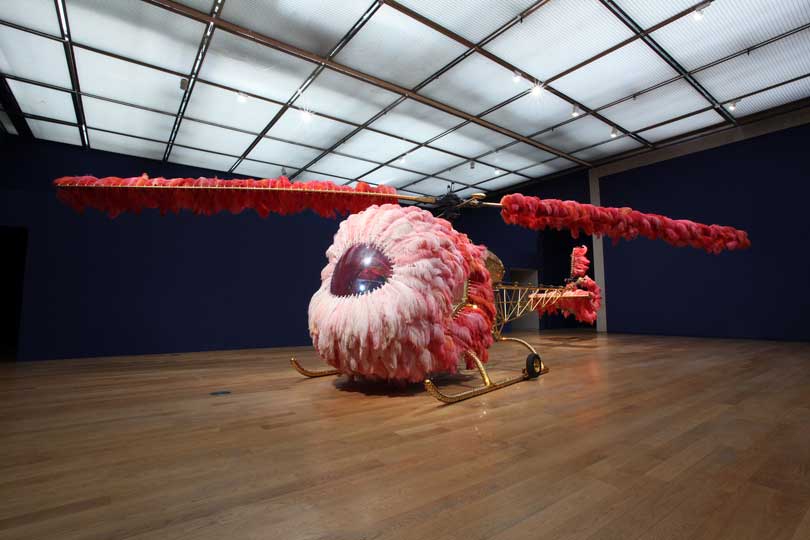
Since then Vasconcelos, born in 1971, has become a major international figure, with teams of technicians, engineers, specialist seamstresses and architects on hand to realise her ever more ambitious ideas. In 2011 her monumental spiralling textile work, Contamination, invaded the Palazzo Grassi in Venice; in 2012 she installed the fantastical pink feathered and gold Lilicoptère in the Chateau at Versailles and last year her blue and white floating pavilion, Trafaria Praia, was Portugal’s contribution to the 55th Venice Biennale.
Lilicoptère (2012), Joana Vasconcelos Courtesy Haunch of Venison/Christie’s, London. Photo: Alan Seabright
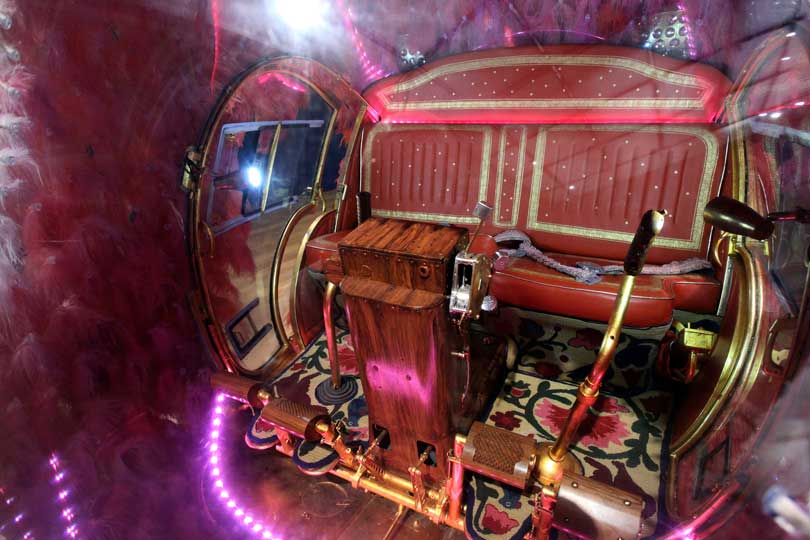
So it was with high expectations that I turned up on press day for Time Machine, Manchester Art Gallery’s expansive Vasconcelos show. Vasconcelos’s work, with its witty appropriations of traditional Portuguese crafts – lace-making, crochet, ceramics – and traditional Portuguese imagery – saints, animals, flowers – makes a perfect fit for a museum incorporating significant collections of Victorian art, in a city built on trade in textiles and ceramics. The artist has been given the run of the place, making and placing 18 works, as she put it to me, ‘wherever I could connect with something.’
In the grand entrance hall, two marble lions on plinths have taken up position at the head of the stairs, like guardians. But far from fierce, these lions (titled Hwarang, 2014) are dressed – muzzled indeed – in black crocheted lace from the Azores. Vasconcelos says ‘They are not outside the building, guarding the power, they are domesticated, more feminine, guarding the people.’
Upstairs, to one side you see the ebullient True Faith (2014), a sculpture created from bulging multi-coloured crocheted cushions, squeezed together into a baroque gold frame, which rhymes with the baroque Venetian parade chair that is displayed nearby. Their rude curvaceousness is at odds with two beautifully rectilinear Canalettos nearby.
A new ceramic and textile installation, Cottonopolis, stands in the Pre-Raphaelite room, framing William Holman Hunt’s painting, The Shadow of Death, but also gesturing to a cabinet and chest of drawers designed by William Burges in 1865 incorporating Persian embroidery and ceramics. It is such conversations between past and present that have led Vasconcelos to call the exhibition, ‘Time Machine’.
For the 2002 connecting atrium of the gallery, Vasconcelos has produced Britannia, a tumbling, joyous spiral of textile reaching from floor to roof. Like a textile triffid or beanstalk, with bulging appendages in myriad colours and textures, it converses enthusiastically with the severely modernist architecture.
It is worth then visiting the temporary exhibition spaces on the top floor, which house four major works from the last few years (her three man-made vehicle works, including the outrageously glamorous Lilicoptère) and the beautiful Full Steam Ahead – three ingenious flower-shaped structures constructed from many domestic irons, all programmed to open up rhythmically like flower heads, and exhale steam.
Full Steam Ahead (red #1), (green #1), (yellow #1) (2012, 2013, 2014), Joana Vasconcelos. Photo: Alan Seabright

The charm of this piece lies in its dream-like transformation of a dull symbol of domestic servitude into a sheerly beautiful, hugely expensive, functionless artwork that provokes and delights simultaneously. You gasp with pleasure.
‘Joana Vasconcelos: Time Machine’ is at the Manchester City Art Gallery until 1 June 2014.
Related Articles:
12 Days: Highlights of 2014 (Emma Crichton-Miller)
Culture Clash at the Royal Museums Greenwich (Miranda Stearn)


